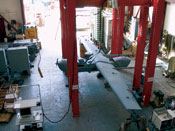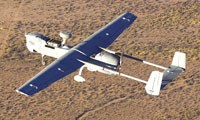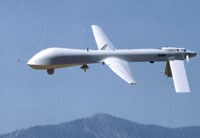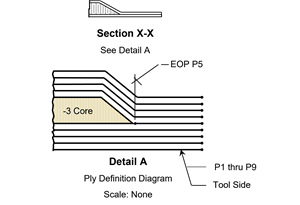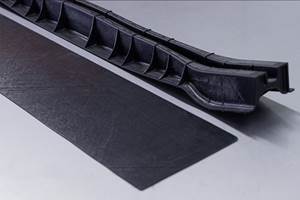Sky's The Limit For Composites-intensive UAVs
Market growth is being spurred primarily by post-9/11 combat actions, homeland security and natural disasters.
Unmanned aerial vehicles (UAVs) are currently the fastest-growing segment of the aerospace sector, with a worldwide dollar value of more than $2 billion (USD). Half the nations on the globe produce or are starting to develop UAV models for a growing number of tasks, which range from military air strikes to high-altitude weather observation. Aerospace America, the magazine of the American Institute of Aeronautics and Astronautics (AIAA), reported in its September 2005 issue ("UAV Worldwide Roundup," p. 26) that 43 countries have gone on record as producing at least one UAV airframe, and more than 500 systems exist. With proven successes in war zones, combat UAVs or UCAVs make up about 85 percent of the market (see HPC May 2002, p. 18 and May 2004, p. 37). Civilian applications, such as reconnaissance and search and rescue, make up the rest.
Composites are the materials of choice for these vehicles, which can range from a few inches in length to the size of a commercial airliner. High strength-to-weight and limited radar signature and signal transparency are the main drivers. Since pilot or passenger risk isn't an issue, UAV designers have a wider range of possibilities open to them to meet specific mission objectives. Military UAV programs are obviously highly sensitive and subject to the U.S. State Dept.'s International Traffic in Arms Restrictions (ITAR) export controls, so most sources were reluctant to go on record, but the following includes a representative sampling of the variety of programs currently in development and production.
A bit of history
The first recorded UAV was built almost a century ago. An "aerial torpedo" was flown automatically in 1916, when Lawrence and Elmer Sperry combined a stabilizing gyro and a steering gyro to control a small airplane. While that World War I-era flight showed the potential strategic value of UAVs, the technology did not take off in a serious way until the late 1950s, says a NASA report. During the Vietnam era, the Firebee and Lightning Bug reconnaissance drones were developed and flown by the U.S. Air Force for the purpose of collecting low- and high-altitude photos. In the 1970s, the U.S. and Israel started experimenting with small, slow and low-cost UAVs resembling large model airplanes and outfitted with new, real-time video cameras. Israel's tactical successes with UAVs during the 1980s led the U.S. military to push for unmanned programs, says NASA. More recently, the U.S. military deployed UAVs in Kuwait and the Balkan conflicts. NASA, meanwhile, funded the nine-year Envi-ronmental Research Aircraft and Sensor Technology (ERAST) program, which helped foster development of engines, sensors and integrated vehicles on the commercial side, particularly for high-altitude, long-endurance (HALE) missions.
In the past few years, UAV system growth has exploded worldwide. "The UAV has become an absolute necessity to warfighters of all nations, all services, all ranks," says the AIAA. China, France, Germany, the U.K., Italy, Japan, Pakistan, Russia and Taiwan are among the many that have fledgling or full-blown UAV programs. Notable among them are the six-nation European Neuron UCAV program, led by Dassault Aviation (Paris, France); the CL-289, a joint development of Canada, France and Germany, built by Dornier GmbH (Friedrichshafen, Germany, an EADS company) and flown successfully more than 450 times in the Balkans; Italy's Sky-X UCAV, first flown in July 2005 and built by Alenia Aeronautica (Pomigliano D'Arco, Italy); and the U.S./U.K. consortium-developed Watchkeeper, in which The Boeing Co. (Seattle Wash.) is a participant. And details are just starting to emerge about Britain's jet-powered, all-carbon Raven unmanned combat air system (UCAS) aircraft, built by BAE Systems (Samlesbury, U.K.), which has been flying since late 2003. Civilian UAV projects also are on the rise — recent natural disasters, including Hurricane Katrina in the U.S., clearly demonstrated the immense benefits of unmanned surveillance for locating survivors under conditions too daunting for manned flights.
The rapid proliferation has raised concerns about overburdening already crowded airspace and attendant problems, such as a serious lag in the development of common communication protocols (see "Proliferation of UAVs in Limited Airspace," p. 51). Yet, even in light of these issues, a new aircraft market study by the Teal Group (Fairfax, Va.) estimates that the UAV market will more than double over the next decade to $4.5 billion in 2014. The study suggests that U.S. programs will account for about 90 percent of the worldwide spending on UAV technology over the next decade, and about 70 percent of the procurement.
"The most significant catalyst to this market has been the enormous growth of UAV funding by the U.S. military, tied to the general trend towards information warfare and net-centric systems," says study co-author and Teal Group senior analyst Steve Zaloga. These robust growth figures translate to solid demand for composite materials over the long term.
An early UAV gets a makeover
One of the first successful all-composite UAVs was the Hunter, developed jointly by Israeli Aircraft Industries (IAI, Tel Aviv, Israel) and TRW Space and Electronics (later purchased by Northrop Grumman) in the late 1980s. The Hunter features a two-engine, push/pull configuration to improve survivability, with twin booms supporting its dual-rudder empennage, designed for runway-based "tactical" missions, meaning flights at lower altitude (<18,000 ft/<5,486m). Northrop Grumman Corp., Integrated Systems (El Segundo, Calif.), which acquired TRW in late 2002, has continued Hunter manufacture and is now fielding an improved, longer-endurance version of the original tactical, multi-function aircraft, says Northrop Grumman's lead aerospace engineer Scott McCourt, who heads the company's Hunter program.
"The original RQ-5A Hunter has been supporting U.S. Army troops for more than a decade," says McCourt, citing more than 19,500 total combat hours to date, accumulated in the Balkans, Kuwait and Iraq. Its replacement, the MQ-5B, is a larger aircraft — about the same size and weight as a small general aviation passenger plane — with an improved wing design and new engines that can burn the U.S. Army's "heavy" JP8 diesel fuel. Wingspan has increased from 29 ft/8.8m to 34.25 ft/10.4m and maximum takeoff weight has increased 22 percent, from 1600 lb/726 kg to 1950 lb/886 kg, and an autonomous takeoff and landing system has been incorporated. The larger wing and improved payload capacity translate to a huge 45 percent increase in "mission endurance" or ability to stay aloft, conducting tactical "ISR" — intelligence, surveillance and reconnaissance. The structural improvements were made possible in part with the assistance of the University of California at San Diego (UCSD), which conducted finite element modeling and testing of the Hunter's structure.
"The model was developed to investigate the structural integrity of the Hunter vehicle under new, larger payload conditions," says UCSD's John Kosmatka, who headed the project. "We validated the model by comparing it to ground vibration measurement tests on an actual Hunter in our laboratory — we measured the vibrations to gain an understanding of its dynamic response to loads." In ground vibration testing, the aircraft is hung by large, soft springs so it is free to vibrate as if in flight, explains Kosmatka. As loads are applied, 50-lb/22.7-kg dynamic shakers impart vibrations of known frequency and amplitude to the aircraft's wings.
The Hunter wing is made up of three parts: the center wing spans the width of the fuselage and mounts to it, while two outer wings, left and right, attach to the center wing with rigid steel bolts (making it modular to allow shipment in the smallest possible transport container). The main structural wing spar, a C-shaped channel, runs the length of both the center wing and outer wings (interrupted by the metallic attachment bulkhead). The center wing also contains an aft structural spar and a recovery parachute, which deploys to aid recovery if necessary. The payload, generally a downward-looking EO/IR (electro-optical infrared) camera, is carried in the center of the blocky fuselage. Two 60-hp motorcycle engines, one at the front and one at the rear of the fuselage, provide the push/pull power.
The outer wings and empennage are wet layed, using two plies of plain-weave carbon fiber fabric to form the inner and outer skins. Plies are oriented at ±45° over a polystyrene core cut to an airfoil shape, which acts as the layup mandrel. EPON epoxy resin is supplied by Hexion Specialty Chemical (Columbus, Ohio). Tail skin laminates also include a single ply of fiberglass.
The central wing, which mates to the fuselage and therefore needs more strength, is produced with woven carbon/epoxy prepreg over Rohacell closed-cell polymethacrylimide (PMI) foam core supplied by Degussa Röhm GmbH & Co. KG (Darmstadt, Germany). The C-channel spar caps are made with unidirectional carbon/epoxy prepreg. Additional hard points or metallic fastener locations can be added to the wings for weapon payloads as dictated by specific missions. Engine cowlings and the fuselage also are prepreg parts, while the circular booms are filament wound with towpreg (carbon tow impregnated with epoxy) over small circular metal mandrels.
While mum on specifics, McCourt notes that the modeling and associated vibration measurements at UCSD led to small but significant changes in structural and laminate design, especially in the center wing, that now enable the aircraft to carry the fuel necessary for longer flight time. The MQ-5B Hunters are currently being built in Israel on an as-needed basis to replace older models, then shipped to the U.S. for final fitting and payload/sensor installation.
"We've demonstrated a 21.3-hour single flight," says McCourt. "With all its capabilities, the aircraft can be flown easily by soldiers in the field."
Autonomous tiltrotor for shipboard operation
One of the most unusual UAVs under development is Bell Helicopter Textron's (Ft. Worth, Texas) Eagle Eye, an unmanned version of the company's manned V-22 Osprey tiltrotor — an aircraft that can ascend and land vertically like a helicopter, yet rotate its nacelles to a horizontal position for normal aircraft flight. The vertical-takeoff-and-landing (VTOL) design makes it particularly suitable for shipboard operation. The company's first customer, the U.S. Coast Guard, has ordered 45 of the aircraft thus far.
According to Mike Mikel, Bell's chief engineer for the company's unmanned aerial systems, the Eagle Eye uses the same aerodynamic principles as the V-22, but is not built in the same way: "We started with a clean sheet of paper and a new design," he explains. The aircraft weighs as much as a manned Bell Jet Ranger commercial helicopter, about 3,000 lb/1,360 kg. Its wingspan is 4.7m/15.2 ft and total length is 5.2m/17 ft. Power is provided by a single Pratt & Whitney turboshaft turbine engine in the center fuselage. The design allows for up to 300 lb/136 kg of payload, typically an EO/IR camera and a radar unit. Maximum endurance is about six hours for tactical ISR missions, at about 20,000 ft/6,096m. "It's simple to maintain and operate," says Mikel. "All you need is a computer and a mouse."
To simplify shipping and storage, the nose and tail are hinged — hinge points are attached to metallic bulkheads — which allows them to fold back against the fuselage to save space. Ken Nunn, Bell's Eagle Eye build team lead, refers to the airframe design as "semi-monocoque," meaning that the structural shell has some internal bulkhead support structures. Upper and lower skins are all composite, made with "conventional autoclave-cured carbon/ epoxy prepregs," says Nunn, adding, "We use composites where any aircraft engineer would typically utilize composites." While layup and fiber architecture is proprietary, the skin laminates are much lighter than would be the case in a manned vehicle. "The structure is sized to the loads, and the laminate, typically isotropic, is relatively thin and highly tailored," he explains. Tooling for the composite parts is primarily made of composites as well, using standard tooling materials.
Other composite elements include the driveshafts that connect the turbine engine to the two rotor/propellers (called proprotors). While the landing gear wheel at present is a metal structure, Nunn and Mikel say they anticipate switching to a composite wheel hub and a solid tire, for overall weight savings.
The Eagle Eye is the first VTOL UAV to receive a certificate of airworthiness for experimental flight-testing from the FAA. While the prototype has been produced, so far, at Bell's Ft. Worth, Texas facility, Bell will select an outside fabricator for full production.
Mikel says the Eagle Eye occupies an important niche for offshore reconnaissance and surveillance. "We're supporting the Coast Guard's deepwater mission, for national security, drug enforcement and fisheries monitoring. VTOL UAS vehicles have a very strong future."
The Predator proves its worth
Simple, cost-effective and lethal. The Predator A, manufactured by General Atomics Aeronautical Systems Inc. (GA-ASI, San Diego, Calif.) has gained that reputation after strategic combat successes in the Balkans, Afghanistan and Iraq. Designed for both high-altitude reconnaissance and air strikes, satellite-controlled Predators are flown remotely by Air Force pilots at Nellis AFB in Nevada. Since 1995, more than 165,000 flight hours have been logged. With a 17m/55-ft wingspan and 8m/27-ft length, the Predator A is about the size of a Cessna 4-place light general aviation plane, and flies even slower. Gross takeoff weight is about 2,300 lb/1,045 kg, including a payload of EO/IR camera and other sensors.
"The Predator A can stay aloft more than 40 hours in a single mission," says GA-ASI's Aircraft Systems president Tom Cassidy. "We're now building an improved Predator B and a jet-powered Predator C for more diverse missions." The second-generation Predator B is turboprop-powered and a significantly heavier aircraft, capable of much heftier weapons payload, and Predator C will be stealthier than its predecessor. According to Cassidy, the first C is scheduled for unveiling sometime in 2006.
Frank Belknap, GA-ASI's composite manufacturing manager at the company's 160,000-ft2 (15,000m2) fabrication facility south of Rancho Bernardo, Calif., reports that the Predator is an all-composite aircraft, hand layed up by GA-ASI technicians using primarily carbon/epoxy prepregs, and cured in the autoclave. However, fiberglass is used in the aircraft's radome and to promote "flexibility" in key locations, according to Belknap. The prepreg materials are cut on a computerized cutting and kitting machine from Lectra (Marietta, Ga.). Core cutting occurs on a Thermwood (Dale, Ind.) 5-axis CNC cutting machine. Laser projection equipment, supplied by Assembly Guidance Systems Inc. (Chelmsford, Mass.), helps ensure repeatable and accurate fabrication, notes Belknap. "With laser-assisted layup, we're able to employ a larger and more diverse technician force, which helps reduce our production costs and increase quality and capacity." Cured laminates are trimmed with a Flow International Corp. (Kent, Wash.) waterjet mounted on a robotic arm that moves along a 40-ft/12.2m overhead gantry.
The multipiece fuselage consists primarily of thin, monolithic uncored laminate, supported by interior ribs and bulkheads and stiffened with honeycomb core in a few key locations. Tubular main and aft wing spars and landing gear legs are produced in closed tools with internal pressure bladders that ensure adequate interior consolidation pressure. Propeller blades also are carbon fiber/epoxy, says Belknap. The Predator A's distinctive inverted (downward-oriented) V-tail "helps protect the pusher propeller," says Cassidy. "With the engine and propeller at the rear, the sensors have an unobstructed view." (Predator B sports a more conventional upward-angled V-tail with downward fin.)
The company is ramping up for greater production, while it is currently turning out two Predator As and one Predator B per month. The price tag for a Predator B is about $10 million per copy, including sensors, a bargain say published reports when compared to the larger but unarmed Global Hawk. So far, the U.S. Air Force has purchased 133 Predators for surveillance and combat duties. The company recently won a $214 million contract to supply the Warrior, a Predator derivative, to the U.S. Army as part of the Systems Development and Demonstration (SDD) phase of Army's Extended Range Multi-Purpose (ER/MP) UAV Program.
"Composites have enabled us to build very light and very strong, long-endurance air-craft that have proven themselves in combat," concludes Cassidy.
Small size, big impact
Many more UAV systems are small and compact. For example, BAI Aerosystems (Easton, Md.), a subsidiary of L3 Communications, makes a backpack-able unit called the Evolution, with a 16 cm/64-inch wingspan and a gross takeoff weight of 8 lb/3.63 kg. A rifle-style pneumatic launcher or even just a strong arm gets the modular, snap-together aircraft flying. The electric-powered Evolution recently won kudos for its success in post-Katrina New Orleans, where 10 of the UAVs were deployed to search for survivors and photograph storm damage.
The Boeing Co.'s (St. Louis, Mo.) ScanEagle, another small composite UAV built by The Insitu Group (Bingen, Wash.) and first flown in 2002, recently surpassed 10,000 combat hours in support of the U.S. Marine Corps and the U.S. Navy. The low-altitude ScanEagle, with a 3m/10-ft wingspan and weighing 38 lb/18 kg, is launched with a pneumatic catapult and has a unique "skyhook" recovery system, in which the craft flies directly into a vertical rope. The rope slides along the wing's leading edge to a hook on the wing tip, which snags the plane out of the air, for effective shipboard or ground-based operations.
Large or small, it's obvious that both military and civilian roles for unmanned aircraft will continue to expand, and with them the demand for composite materials. An Air Force general has been quoted as saying, "I don't think UAVs will replace manned aircraft — at the same time, I think they're here to stay. We're going to see more and more integration of UAVs where they fit best in the mission."
Related Content
Heat mapping simulation to improve AFP parts
An optical model developed for Coriolis Composites’ SimuReal AFP process simulation software enables verification of energy distributions during AFP to better define heating laws.
Read MoreThe basics of composite drawing interpretation
Knowing the fundamentals for reading drawings — including master ply tables, ply definition diagrams and more — lays a foundation for proper composite design evaluation.
Read MoreOptimized approach to predict delamination failure in CFRTP structures
ARRK Engineering and Mitsui Chemicals improved delamination prediction accuracy to help optimize absorbed energy/failure load for an overmolded TAFNEX CF/PP UD tape bumper beam.
Read MoreCarbon fiber, bionic design achieve peak performance in race-ready production vehicle
Porsche worked with Action Composites to design and manufacture an innovative carbon fiber safety cage option to lightweight one of its series race vehicles, built in a one-shot compression molding process.
Read MoreRead Next
Developing bonded composite repair for ships, offshore units
Bureau Veritas and industry partners issue guidelines and pave the way for certification via StrengthBond Offshore project.
Read MoreVIDEO: High-volume processing for fiberglass components
Cannon Ergos, a company specializing in high-ton presses and equipment for composites fabrication and plastics processing, displayed automotive and industrial components at CAMX 2024.
Read More“Structured air” TPS safeguards composite structures
Powered by an 85% air/15% pure polyimide aerogel, Blueshift’s novel material system protects structures during transient thermal events from -200°C to beyond 2400°C for rockets, battery boxes and more.
Read More




